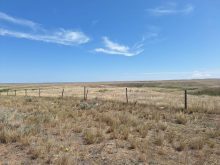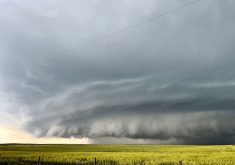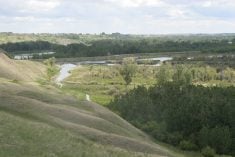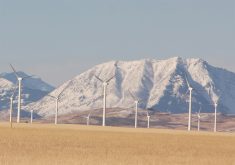ODESSA, Sask. — When a plow wind whirled through Bette Reiss’s mixed farm at Odessa, the intrepid crop reporter stayed above ground to keep watch.
“Most people head to the basement. We are out on the porch,” said Reiss, a volunteer crop reporter who has been relaying details of crops and weather in her rural municipality to Saskatchewan Agriculture for more than a quarter century.
“The walls near the porch were shaking, the shingles were all over the yard,” she recalled.
But fortunately, the cattle raised by Bette and her husband, Dennis, were spared harm.
Read Also

Agriculture ministers agree to AgriStability changes
federal government proposed several months ago to increase the compensation rate from 80 to 90 per cent and double the maximum payment from $3 million to $6 million
Reiss’s reasons for volunteering her time are simple.
“I like seeing what’s going on, not just in my backyard,” she said.
“I’m not a weather specialist, just a weather observer. There’s nothing you can do about the weather but sit back for the ride and hope for the best.”
Her interest in the weather is shared by the 200 volunteer crop reporters who watch the skies in Saskatchewan’s growing regions.
Shannon Friesen, regional crops specialist at Saskatchewan Agriculture in Moose Jaw, said they are the eyes and ears of their rural regions, documenting in detail crop progress, soil moisture, disease prevalence, weather details and much more for the weekly crop report.
“We are the only province who relies on such a large amount of volunteers,” she said.
Friesen said many spend a dozen or more hours a week collecting the data, talking with neigh-bours, visiting coffee row, completing the questionnaire and sending in the information.
“They provide us with amazing information. We can’t publish it all but certainly appreciate it,” she said.
“Crop reporters provide great detailed analysis of exactly what’s going on.”
The information is used by the ministry and by businesses around the world.
“Without them, it would be a lot harder,” said Friesen.
“They are the backbone of what we do. Saskatchewan is such a vast province and in every area, there is something different happening every day.”
Reiss said she’s the go-to person in her region, with people often calling her to check on weather events.
Retired crop reporter and farmer Cecilia Kotylak said weather is an endlessly fascinating topic of conversation.
Kotylak, who retired from reporting in 1998 after 15 years, felt well equipped to report, considering her family’s cropland spread throughout the Montmartre region.
Twice each year, Kotylak would push a special metal rod into the ground to determine soil moisture, carefully compiling her information so that she could phone it in to Saskatchewan Agriculture each week.
She said weather monitoring stays with her even today.
“It will never go away in my head,” said Kotylak.
She recalled the year grasshoppers arrived in droves.
“The grasshoppers moved in and they go through the crops like you wouldn’t believe. Part of our RM had severe damage,” Kotylak said.
One year, it was bertha armyworms that swept through the grain belt and left damage in their wake within days.
She recalled when a plow wind “just laid down the crops,” leaving behind fields that were salvageable only for livestock feed.
She has seen a shift in weather patterns over the years, citing more abrupt and extreme changes than in the past.
Kotylak retired her rain gauge after her husband died and when newer crops arrived that were less familiar to her.
“I didn’t think it was right to give a report if I didn’t know what was going on,” she said.
Friesen said there are three reporters who have reported every year since 1976.
Today, their phoned-in and faxed reports have been largely replaced by emails and online surveys.
Friesen said crop reporting formally began in 1976, but was preceded by informal crop reporting.
In the beginning, reporters would submit information to the local ag rep.
Volunteers would receive their choice of a subscription to The Western Producer, Free Press Weekly, Farm Light and Power or a Canada yearbook. Today, volunteers receive a gift annually and when they reach certain milestones.
For Reiss, that included a trip to Regina, a dinner and tour at the Saskatchewan legislature and an introduction to the agriculture minister to mark her 25 years of service.
6 frosty facts
- What is black frost and how does it form? This spring, hard frost smoked canola seedlings on hundreds of thousands of acres in western Manitoba and eastern Saskatchewan. Manitoba Agriculture crop production adviser Elmer Askew described it as a “black frost,” one where dew doesn’t form and there is little moisture to protect the plants.
- Is there any relationship between a full moon and frost? Drew Lerner, president of World Weather Inc., says there is no statistical evidence that frost is more likely during a full moon. Cornell University scientists looked at 100 years of weather records at four locations in the U.S. Northeast and found that a full moon didn’t increase the risk of frost.
- What is hoarfrost? Snowflakes are not frozen water and frost is not frozen dew. When water vapour molecules contact a frozen subfreezing surface, such as a windshield, they jump from the gaseous to solid state, leading to a coating of tiny ice crystals. When there is more moisture in the air, the ice crystals can grow and develop more intricate patterns. This is hoarfrost.
- Do Russian children like frost? Probably. That’s because the Russian Santa Claus is named Deed Moroz, or Father Frost.
- Does frost arrive later in the year than it used to? The first fall frost in Saskatchewan now arrives later than it did in the 1960s. Climatologists say the average date of fall frost in central Saskatchewan is stretching into late September.
- How old is Frosty? The Frosty the Snowman TV movie first appeared on CBS in 1969. Gene Autry recorded the first version of the Frosty the Snowman song in 1950.
Source: staff research

















